Overview
Microsoft’s new AI model captures attention by significantly enhancing operational efficiency. It automates routine tasks and analyzes workflows to identify bottlenecks, thus freeing human resources for strategic initiatives. This model employs advanced algorithms and Robotic Process Automation (RPA) to streamline operations. By reducing costs, it empowers organizations to leverage data-driven decision-making for sustained competitive advantage.
Consider how this technology could transform your operations. The detailed insights provided in the article illustrate the practical applications of these advanced tools. With the ability to analyze workflows, organizations can pinpoint inefficiencies and implement targeted improvements. This not only optimizes processes but also fosters a culture of continuous improvement.
Ultimately, embracing this AI model positions organizations to thrive in a competitive landscape. By harnessing the power of automation and data analysis, businesses can focus on strategic initiatives that drive growth and innovation. The potential for enhanced decision-making capabilities is immense, making this an essential consideration for forward-thinking leaders.
Introduction
In a world where operational efficiency can make or break a business, Microsoft’s new AI model emerges as a game-changer. This innovative tool is poised to revolutionize how organizations manage their workflows. By harnessing advanced algorithms and machine learning, it promises to streamline processes, minimize bottlenecks, and automate mundane tasks. As a result, teams can redirect their focus toward strategic initiatives.
As companies increasingly rely on data-driven insights to maintain a competitive edge, the integration of such AI technologies becomes essential. Real-world case studies illustrate the transformative power of automation, showcasing how organizations can enhance productivity and drive growth. It is time for businesses to embrace these advancements in an ever-evolving landscape.
The Significance of Microsoft’s New AI Model for Operational Efficiency
Microsoft has unveiled an AI model that comprehensively understands diverse organizational activities, representing a significant leap forward in efficiency. By utilizing sophisticated algorithms and machine learning techniques, this model meticulously analyzes workflows, identifying bottlenecks and recommending optimizations. Its primary advantage lies in automating routine tasks through Robotic Process Automation (RPA), which frees human resources to concentrate on strategic initiatives that drive growth.
This transition not only enhances productivity but also substantially reduces expenses, positioning the AI model as an essential resource for entities striving to excel in a competitive environment.
As the reliance on data-driven decision-making intensifies, the incorporation of such AI models is becoming vital for maintaining a competitive edge and fostering innovation. Current statistics reveal that 65% of organizations are either utilizing or actively exploring AI technologies in data and analytics, as noted by Amani Undru, BI & Data Strategist at ThoughtSpot. This underscores the urgency for businesses to adopt these advancements.
Moreover, with 30% of business proprietors expecting AI’s involvement in creating website content, the potential for AI to evolve from a simple productivity booster to a transformative force is evident.
Case studies illustrate the tangible benefits of AI in functional effectiveness. For instance, advancements in hardware, including specialized chips, have significantly enhanced AI performance, enabling real-time applications across various sectors. These innovations empower enterprises to adopt robust AI solutions, such as EMMA RPA and Microsoft Power Automate, which improve customer service and scalability, particularly during peak demand periods.
As leaders are encouraged to establish bold AI commitments, focusing on human-centric development will be crucial to transforming AI into a tool that not only enhances productivity but also amplifies human agency in the workplace.
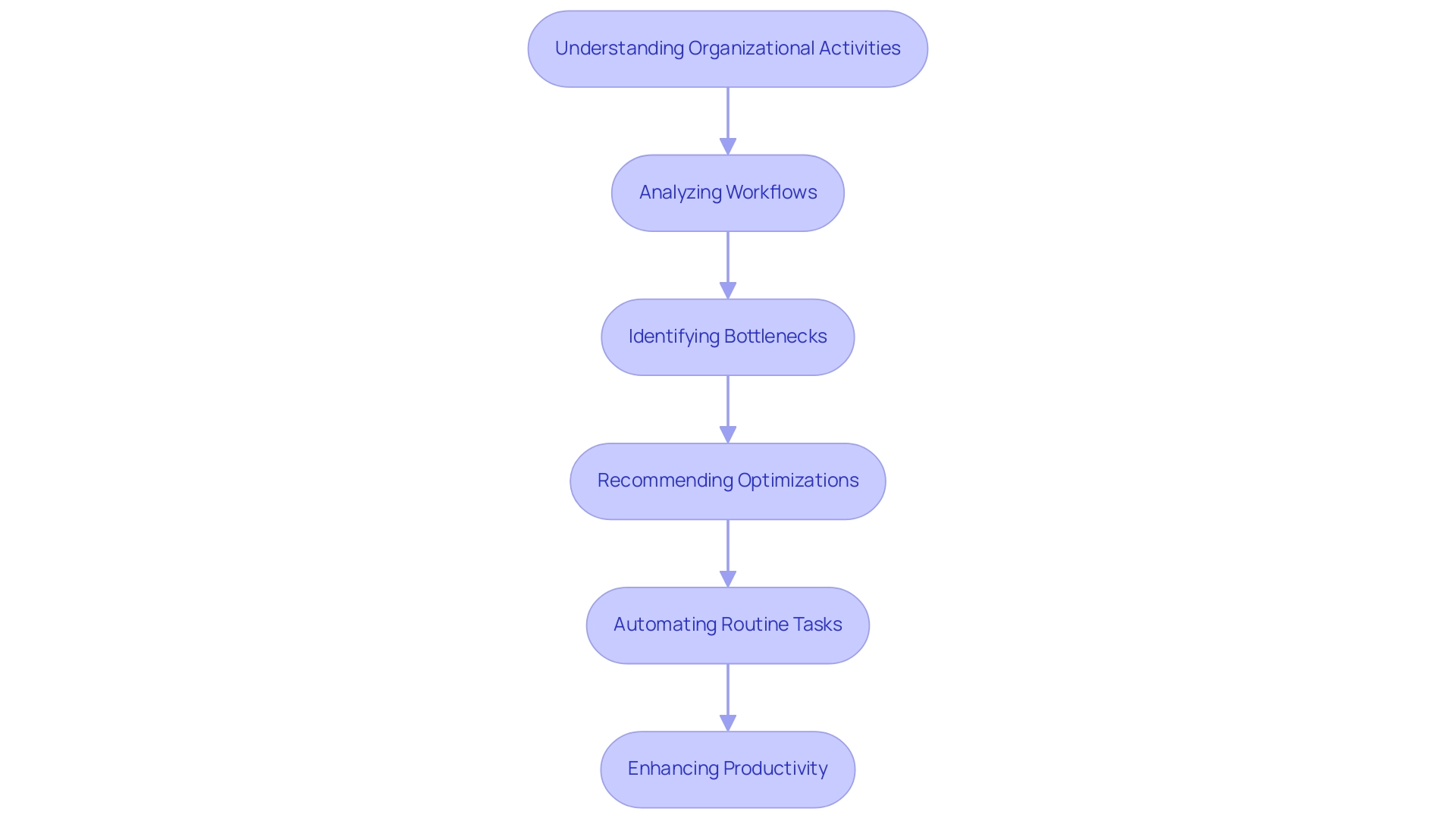
Identifying Challenges in Operational Efficiency
Organizations today face numerous obstacles that significantly impede performance. Among the most prevalent issues are manual, repetitive tasks that drain valuable time and resources, along with employee resistance to change and inadequate integration of existing systems. These factors contribute to rising operational costs and diminished productivity.
Recent statistics reveal a stark disconnect: while 74% of leaders claim to involve employees in creating change strategies, only 42% of employees feel genuinely included in these initiatives. This gap can stifle progress.
The rapid pace of technological advancement further complicates matters, often overwhelming teams as they struggle to adapt to new tools and processes. For instance, in 2024, 67% of businesses reported utilizing process automation to enhance visibility across their systems; yet many still grapple with transforming unstructured data into actionable insights. Firms like Tesla illustrate the possibilities of hyper-automation, combining AI and IoT to achieve significant cost savings and improved production effectiveness, reinforcing the trend of automation within business strategies.
A compelling case study showcases how a mid-sized company, Creatum GmbH, effectively addressed these challenges by adopting GUI automation. By automating data entry, software testing, and legacy system integration, the company reduced data entry errors by 70%, accelerated testing processes by 50%, and improved workflow efficiency by 80%. This transformation not only simplified operations but also yielded a return on investment within six months, demonstrating the tangible benefits of automation in enhancing efficiency.
Recognizing these challenges is essential for organizations seeking to implement effective solutions. Microsoft has unveiled an AI model that comprehends how Quantive StrategyAI serves as a transformative tool, assisting organizations in aligning strategic goals and enhancing decision-making through data insights. Additionally, Enate’s AI-driven workflows provide a comprehensive solution for managing and optimizing workflows, further boosting overall performance.
By leveraging such innovations, organizations can streamline operations and empower their teams to concentrate on strategic, value-adding activities, ultimately driving growth and innovation.
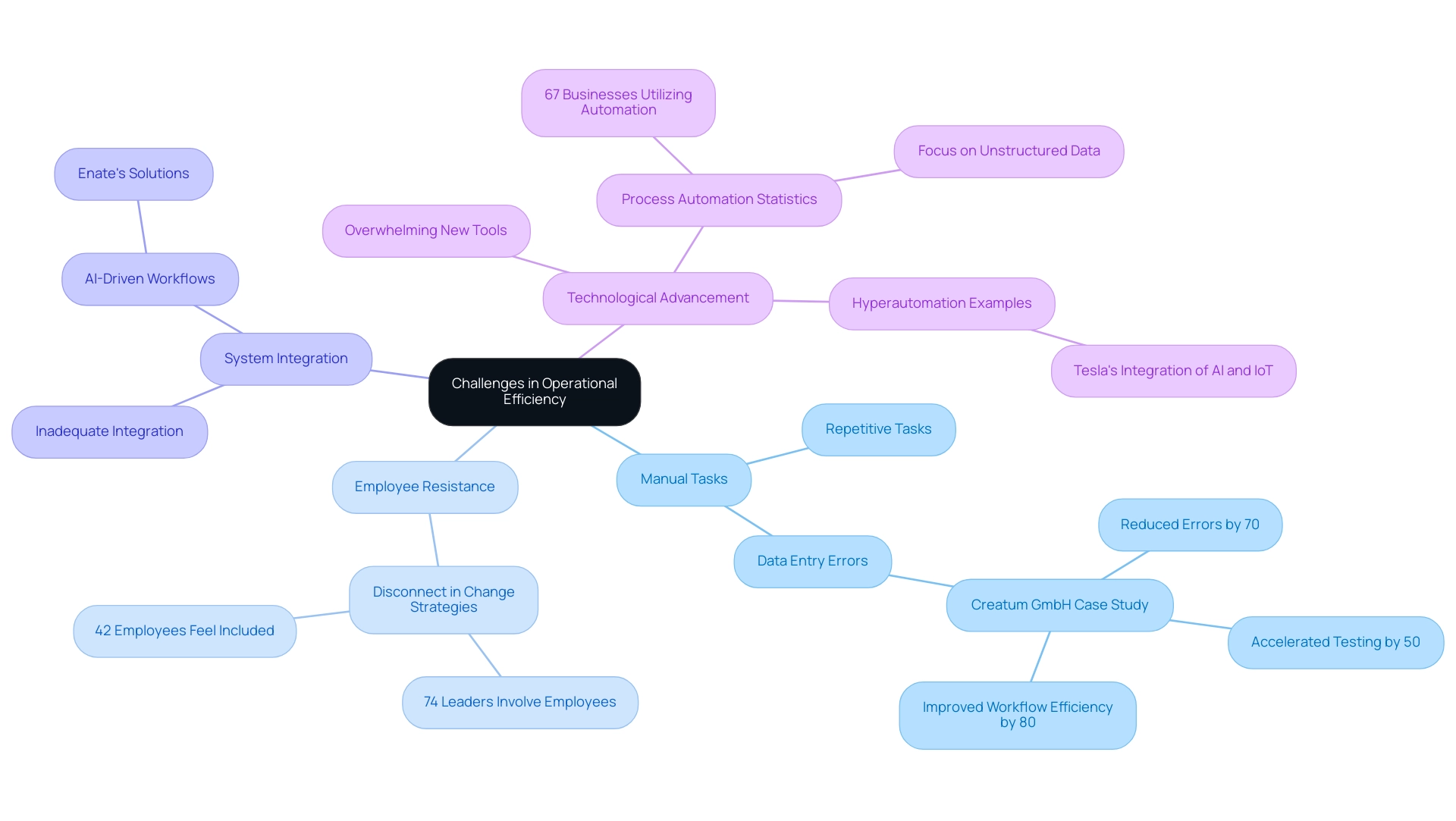
Leveraging Robotic Process Automation to Enhance Efficiency
Robotic Process Automation (RPA) stands as a pivotal solution for enhancing operational efficiency by automating repetitive tasks that have traditionally burdened employees. In today’s fast-paced work environment, companies grapple with challenges such as staffing shortages and outdated systems that hinder productivity. By adopting RPA, organizations can streamline workflows, significantly reduce human error, and cut processing times.
Consider routine tasks such as data entry, invoice processing, and report generation. These can be automated, freeing teams to concentrate on higher-value activities that leverage human judgment and creativity. The benefits of RPA extend beyond mere efficiency gains. Recent statistics reveal that over 90% of small and medium-sized businesses (SMBs) are contemplating AI and automation services to bolster their competitive edge. In the finance and banking sectors, where RPA adoption is particularly robust, 65% of firms plan to increase their automation investments.
This trend is propelled by substantial time and cost savings associated with RPA; 79% of finance companies report time savings, while 61% have experienced cost reductions. Furthermore, a report by PwC predicts a necessary reshaping of finance roles through automation, underscoring the transformative impact of RPA in this sector.
Moreover, the integration of RPA not only enhances accuracy but also significantly boosts employee satisfaction. By eliminating mundane tasks, RPA fosters a more engaged and productive workforce, allowing employees to focus on strategic initiatives. As organizations strive to optimize their operations and combat the challenges of repetitive tasks and staffing shortages, RPA emerges as a critical component of their digital transformation strategies, reshaping roles and enhancing collaboration across teams.
The ongoing evolution of RPA technology promises to further revolutionize operational workflows, making it an indispensable tool for businesses aiming to thrive in a data-rich environment. Significantly, the high percentage of manual processes still in place indicates untapped potential for further improvements.
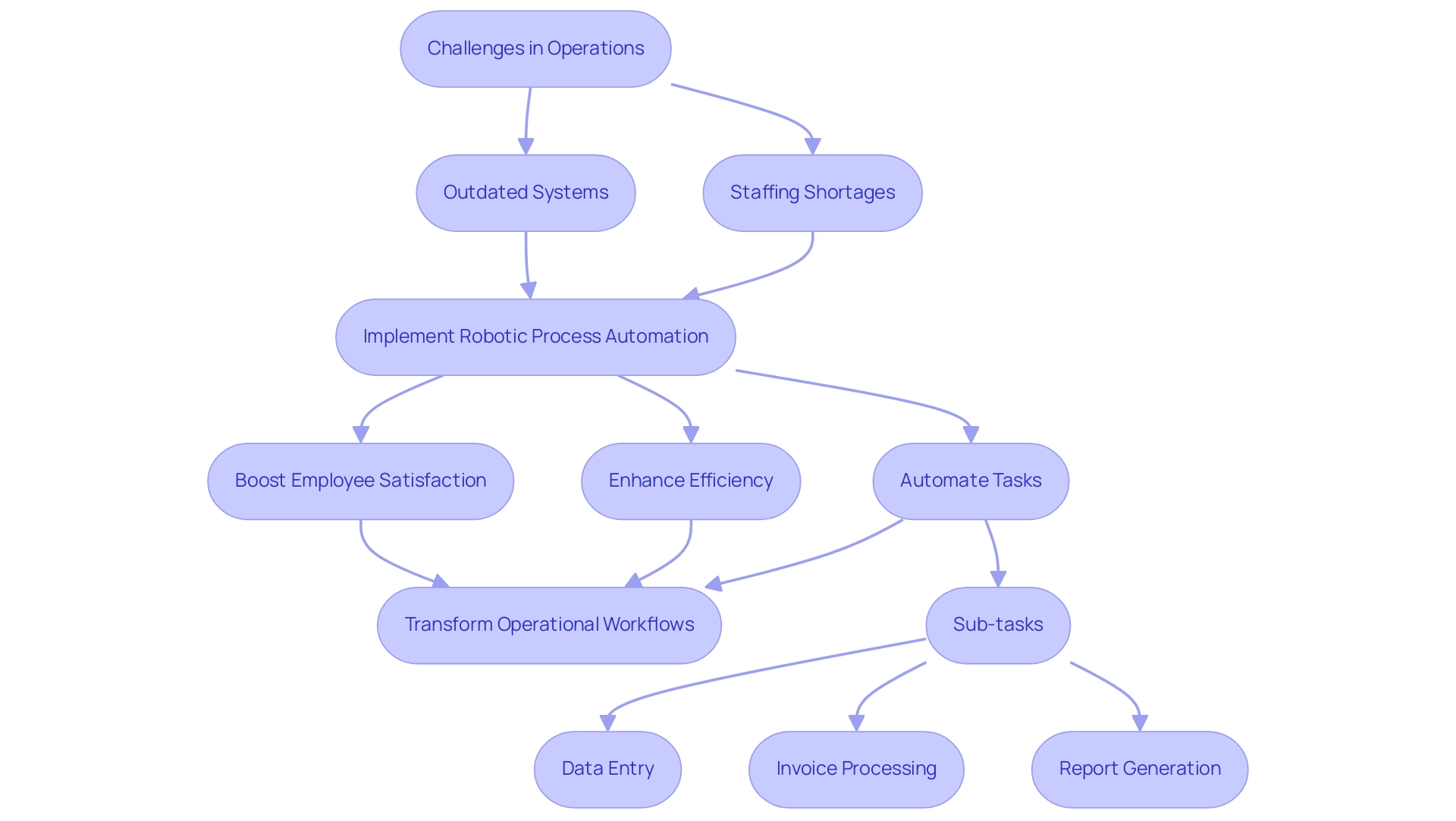
Tailored AI Solutions: Simplifying Technology Adoption for Businesses
Navigating the intricate landscape of artificial intelligence can be overwhelming for many entities, highlighting the necessity of tailored AI solutions for effective technology adoption. By customizing AI applications to meet specific business requirements, companies like Creatum GmbH can ensure these technologies support their functional goals and significantly enhance overall productivity. For example, a retail company may benefit from an AI solution designed to optimize inventory management, while a financial institution could leverage AI to improve compliance processes.
Moreover, the integration of Robotic Process Automation (RPA) can further streamline manual workflows, reducing errors and freeing up valuable resources for more strategic tasks. This synergy between RPA and tailored AI solutions not only enhances efficiency but also creates a robust framework for productivity. As Satya Nadella, chairman and CEO of Microsoft, articulated, “For the first time, we have the access to AI that is as empowering as it is powerful.”
Recent statistics reveal that 51 percent of executives anticipate that generative AI will contribute to a revenue increase of over 5 percent within the next three years, underscoring the potential financial benefits of customized implementations.
However, case studies indicate that while organizations are experimenting with generative AI tools, the tangible impact on bottom-line results remains limited, as noted in the study titled ‘Gen AI Deployment and Value Creation.’ This observation suggests that many are still in the early stages of realizing the full potential of these technologies. It reinforces the notion that customized AI applications, alongside RPA and Business Intelligence, are not merely advantageous but essential for achieving meaningful operational improvements and maximizing return on investment.
As companies embark on their digital transformation journeys, the significance of tailored AI solutions becomes increasingly apparent, acting as a catalyst for enhancing productivity and fostering innovation.
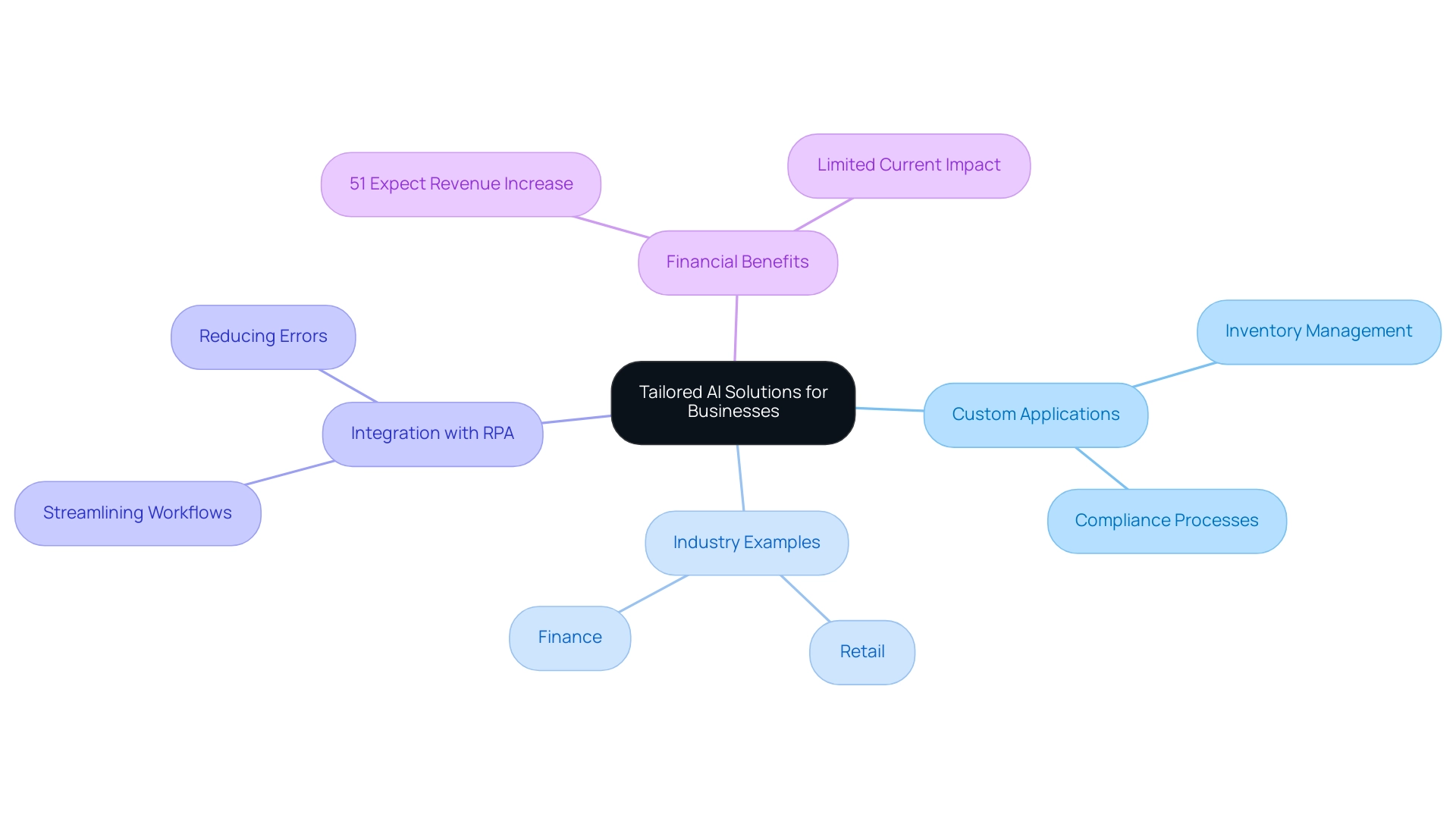
Transforming Data into Actionable Insights for Informed Decision-Making
In today’s data-rich environment, the ability to transform raw information into actionable insights is crucial for effective decision-making. Microsoft has introduced an AI model that comprehends extensive datasets, playing a pivotal role in this transformation by skillfully analyzing patterns that might otherwise remain hidden. By leveraging advanced analytics and machine learning, organizations can gain profound insights into their operations, customer behaviors, and market dynamics.
This data-centric approach empowers businesses to make informed strategic decisions that enhance operational efficiency and foster growth.
In this context, leveraging Robotic Process Automation (RPA) is essential, as it automates manual workflows, significantly boosting productivity and minimizing errors. For instance, predictive analytics enables organizations to anticipate customer needs, optimize resource allocation, and elevate overall performance. A noteworthy statistic reveals that 58 percent of HR leaders have reported productivity improvements due to AI integration, underscoring the tangible benefits of data-driven strategies.
Moreover, the financial services sector exemplifies this trend; numerous banks and credit unions are actively pursuing digital transformation initiatives. Projections indicate that by 2025, 25% of the insurance industry will adopt automated processes. This shift highlights the ongoing evolution within the sector, driven by technological advancements.
However, organizations encounter challenges such as employee resistance and a lack of expertise, which can impede their digital transformation efforts. As businesses increasingly rely on data to shape their strategies, the critical importance of effective data transformation becomes clear. As noted by Quantive StrategyAI, “Quantive StrategyAI equips your business to make smarter decisions and stay prepared for the unexpected.”
Organizations that effectively leverage AI for data analysis not only enhance their decision-making capabilities but also position themselves for sustained success in a competitive marketplace. Furthermore, the upcoming WalkMe webinar discussing the Soda 2025 report will provide valuable insights into successful digital adoption strategies, further emphasizing the necessity of staying informed in this rapidly evolving landscape.
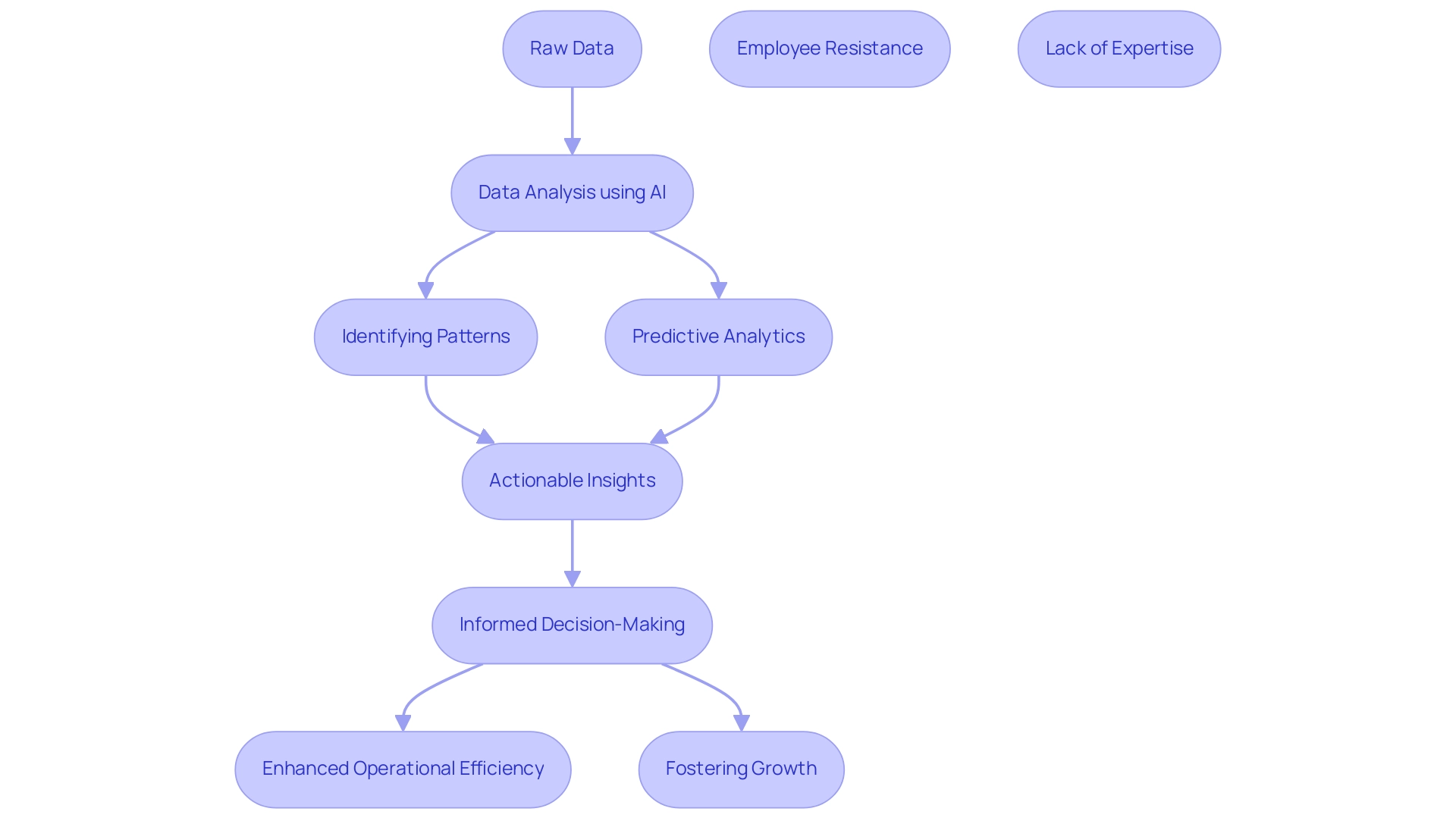
Conclusion
In conclusion, the imperative for businesses to adopt and integrate AI solutions that enhance operational efficiency and foster innovation has never been clearer. By embracing these technologies, organizations can streamline their operations and empower their teams to concentrate on high-value activities that drive growth. The future of work is upon us, fueled by intelligent automation and data-driven decision-making. Are you ready to harness the power of AI and transform your business landscape?
Frequently Asked Questions
What is the main purpose of Microsoft’s newly unveiled AI model?
The AI model aims to comprehensively understand diverse organizational activities, enhancing efficiency by analyzing workflows, identifying bottlenecks, and recommending optimizations.
How does the AI model improve efficiency within organizations?
It utilizes sophisticated algorithms and machine learning techniques to automate routine tasks through Robotic Process Automation (RPA), allowing human resources to focus on strategic initiatives that drive growth.
What are the financial benefits of implementing this AI model?
The model enhances productivity and substantially reduces operational expenses, making it an essential resource for organizations aiming to excel in a competitive environment.
Why is the adoption of AI technologies becoming urgent for businesses?
As reliance on data-driven decision-making increases, incorporating AI models is vital for maintaining a competitive edge and fostering innovation. Currently, 65% of organizations are utilizing or exploring AI technologies.
What is the expected impact of AI on website content creation?
About 30% of business owners expect AI to play a role in creating website content, indicating its potential to evolve from a productivity booster to a transformative force.
Can you provide an example of how AI has improved operational effectiveness?
A case study showed that advancements in hardware and specialized chips have significantly enhanced AI performance, enabling real-time applications across various sectors, such as customer service and scalability during peak demand.
What challenges do organizations face in improving performance?
Common challenges include manual, repetitive tasks, employee resistance to change, and inadequate integration of existing systems, which lead to rising operational costs and reduced productivity.
What is the disconnect between leaders and employees in change strategies?
While 74% of leaders claim to involve employees in creating change strategies, only 42% of employees feel genuinely included, which can hinder progress.
How are businesses addressing the challenges of technological advancement?
Many businesses are utilizing process automation to enhance visibility across systems, but many still struggle to transform unstructured data into actionable insights.
What significant results did Creatum GmbH achieve by adopting GUI automation?
Creatum GmbH reduced data entry errors by 70%, accelerated testing processes by 50%, and improved workflow efficiency by 80%, achieving a return on investment within six months.
What tools are mentioned as part of the AI-driven solutions for organizations?
Tools like Quantive StrategyAI and Enate’s AI-driven workflows are highlighted for assisting organizations in aligning strategic goals and optimizing workflows, thereby boosting overall performance.

